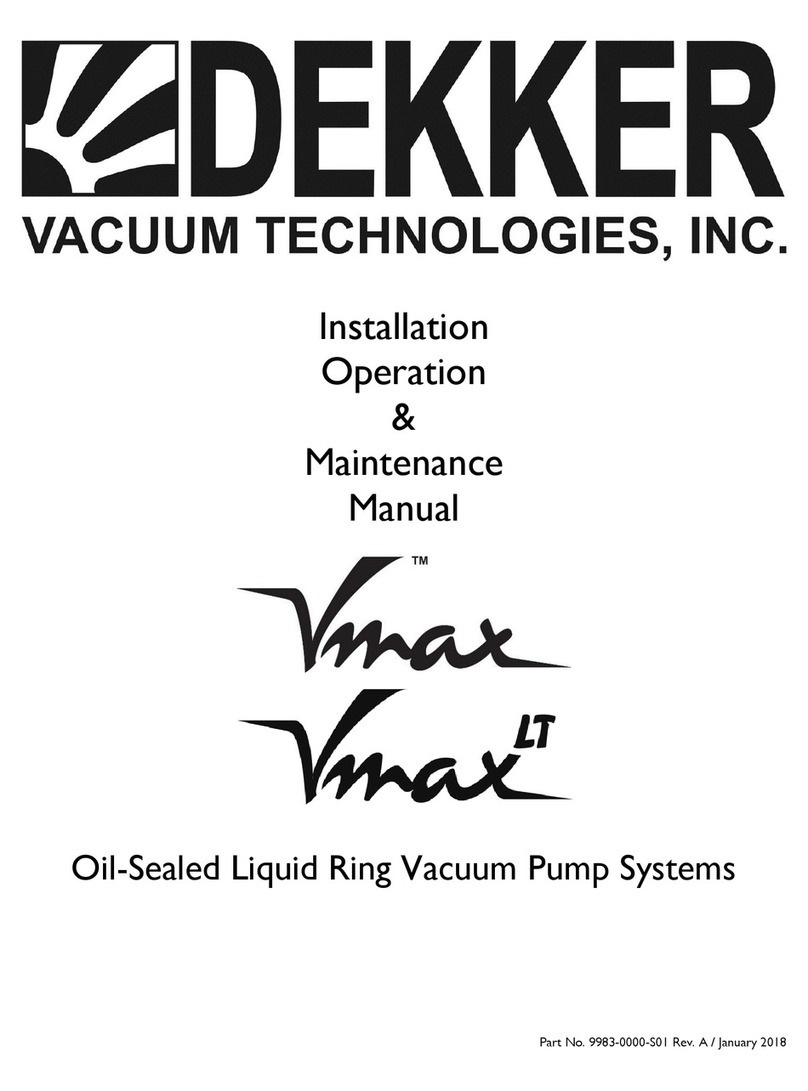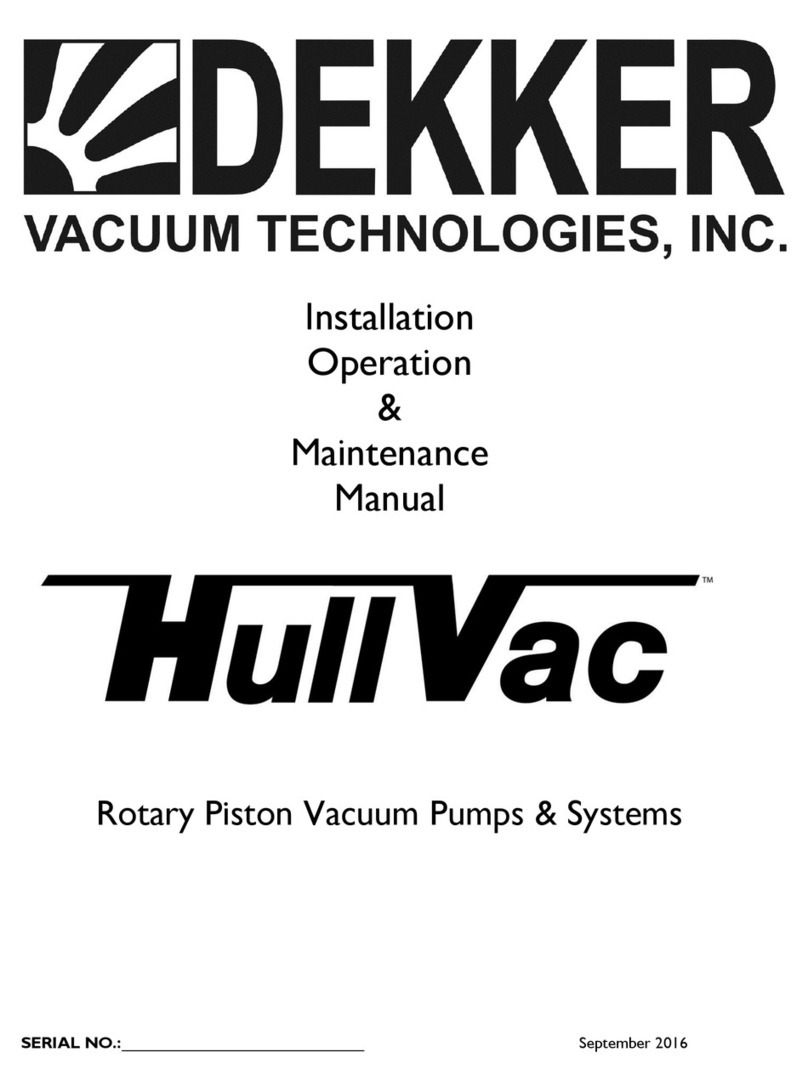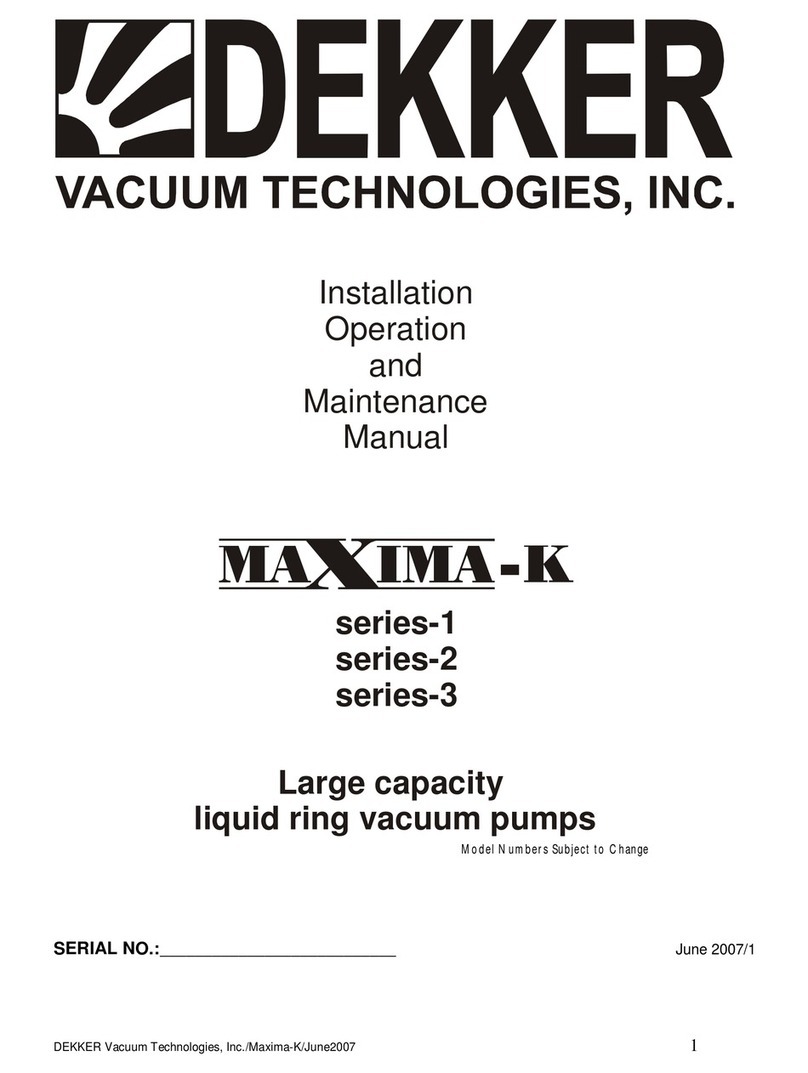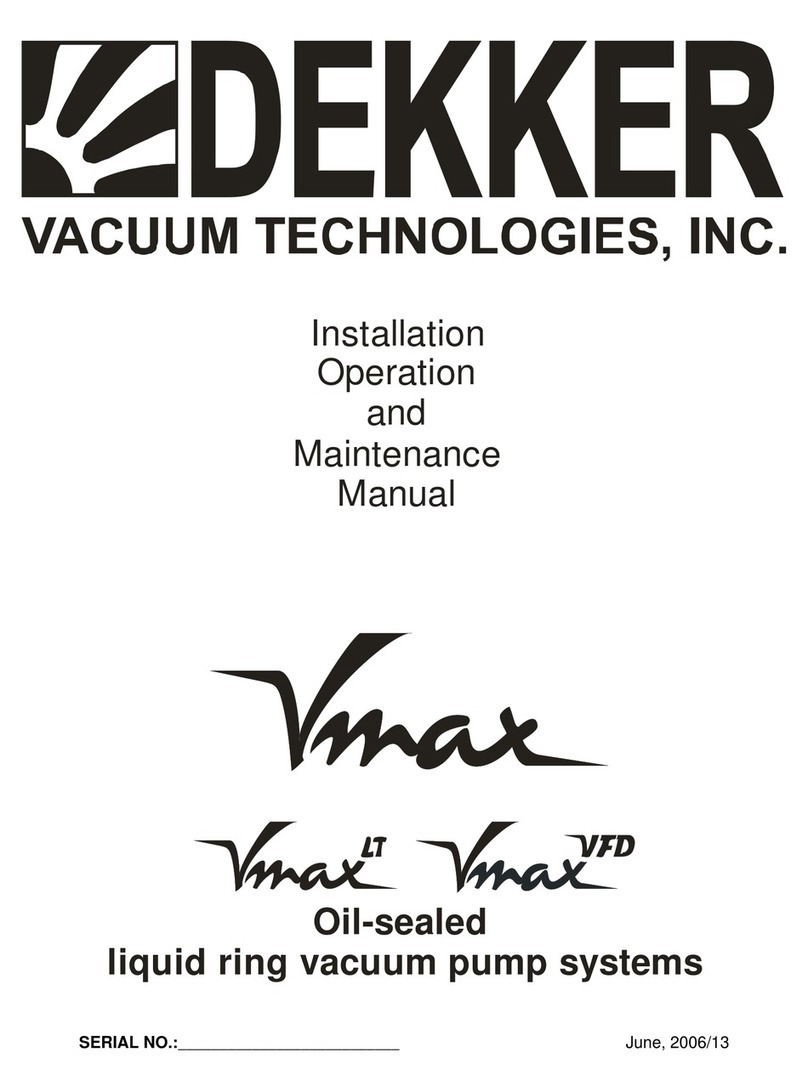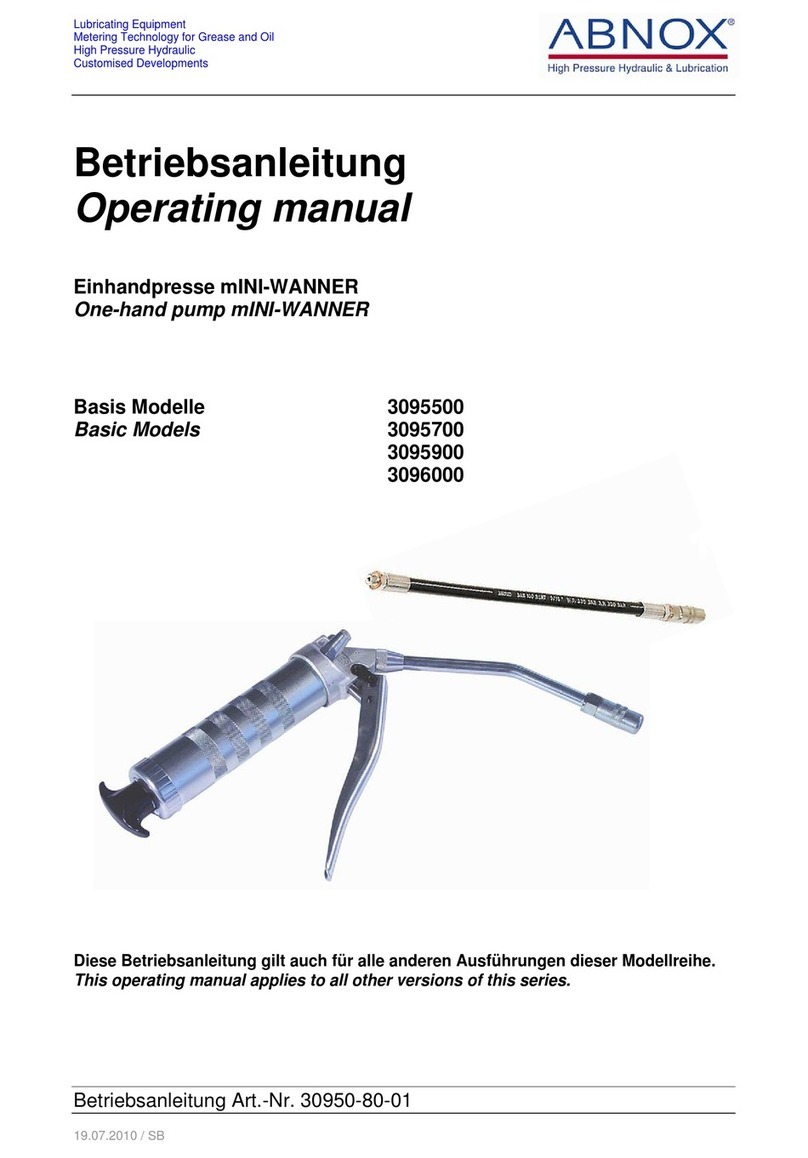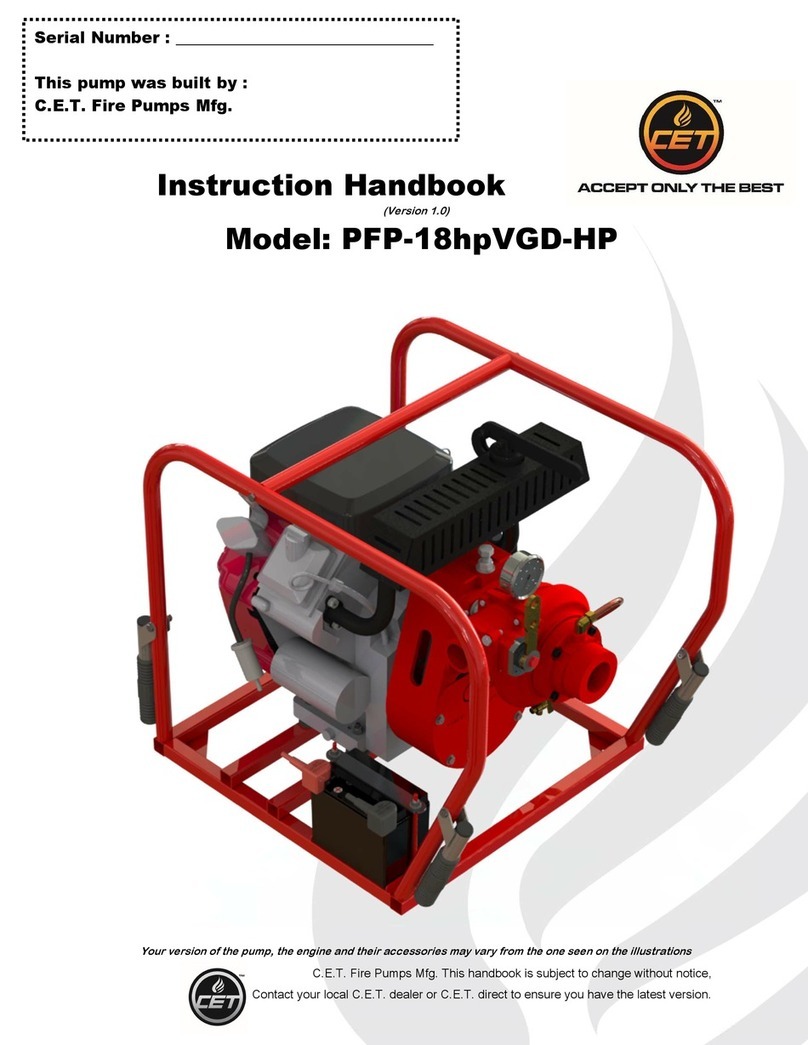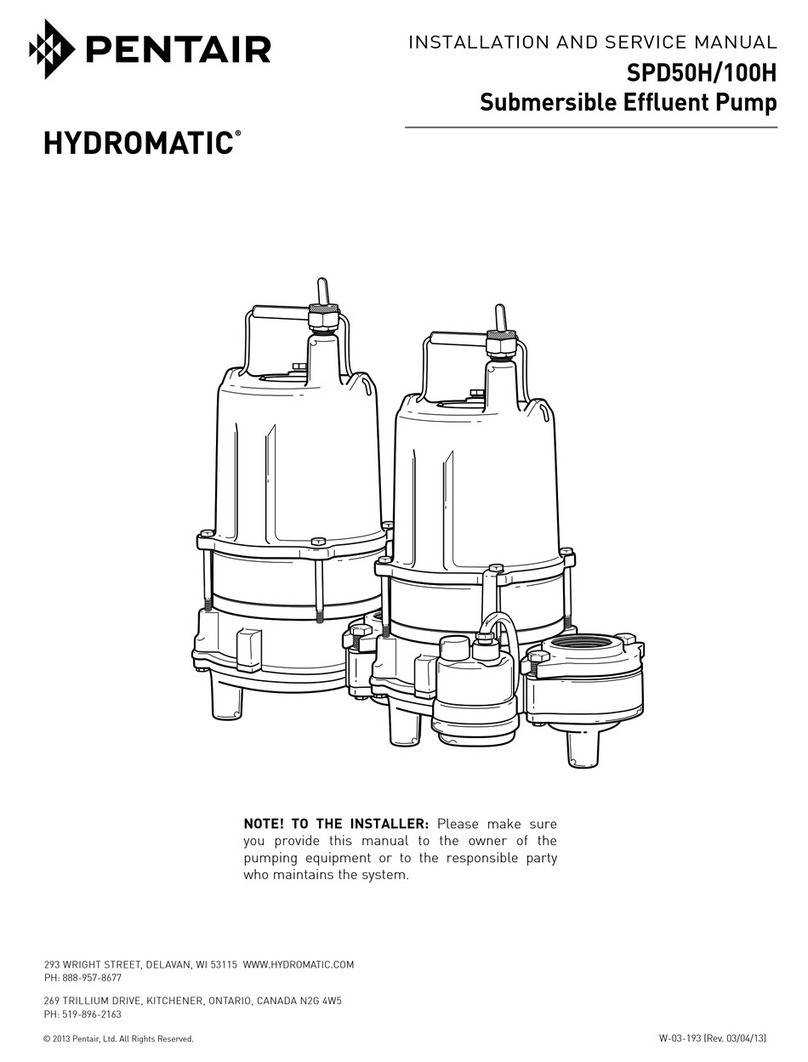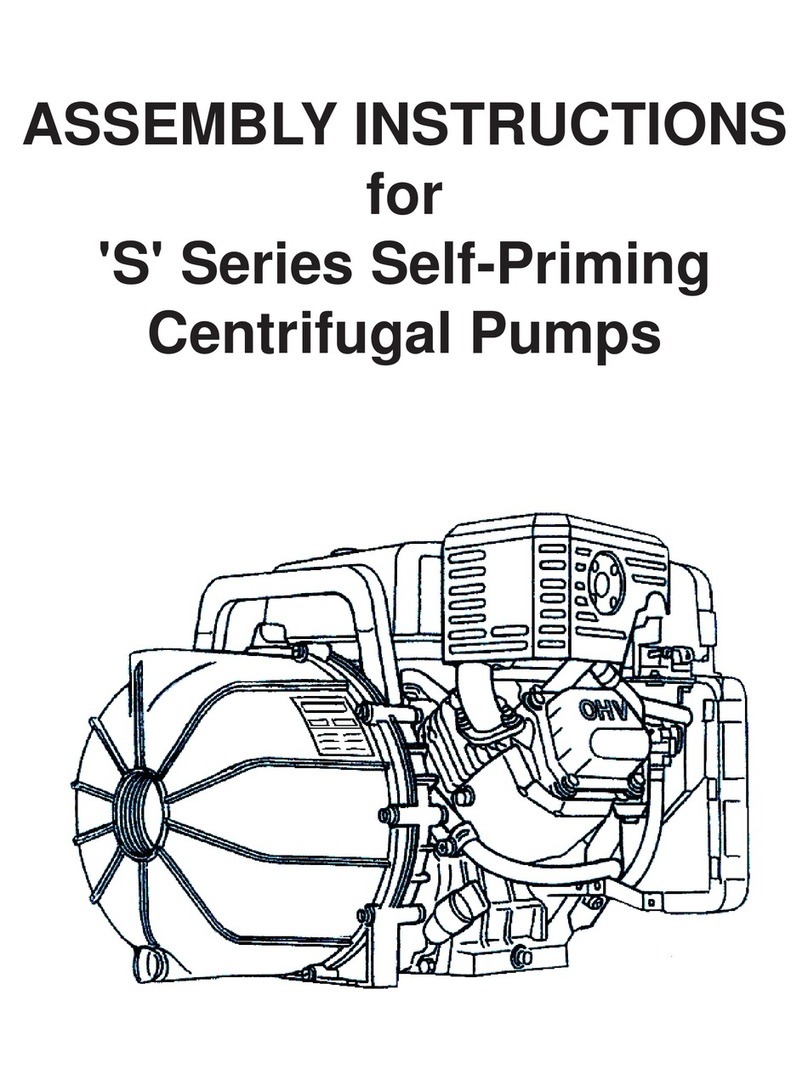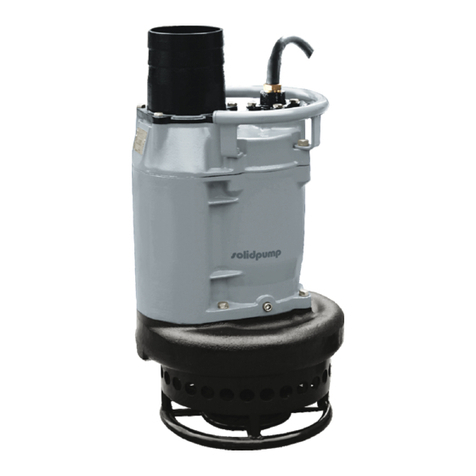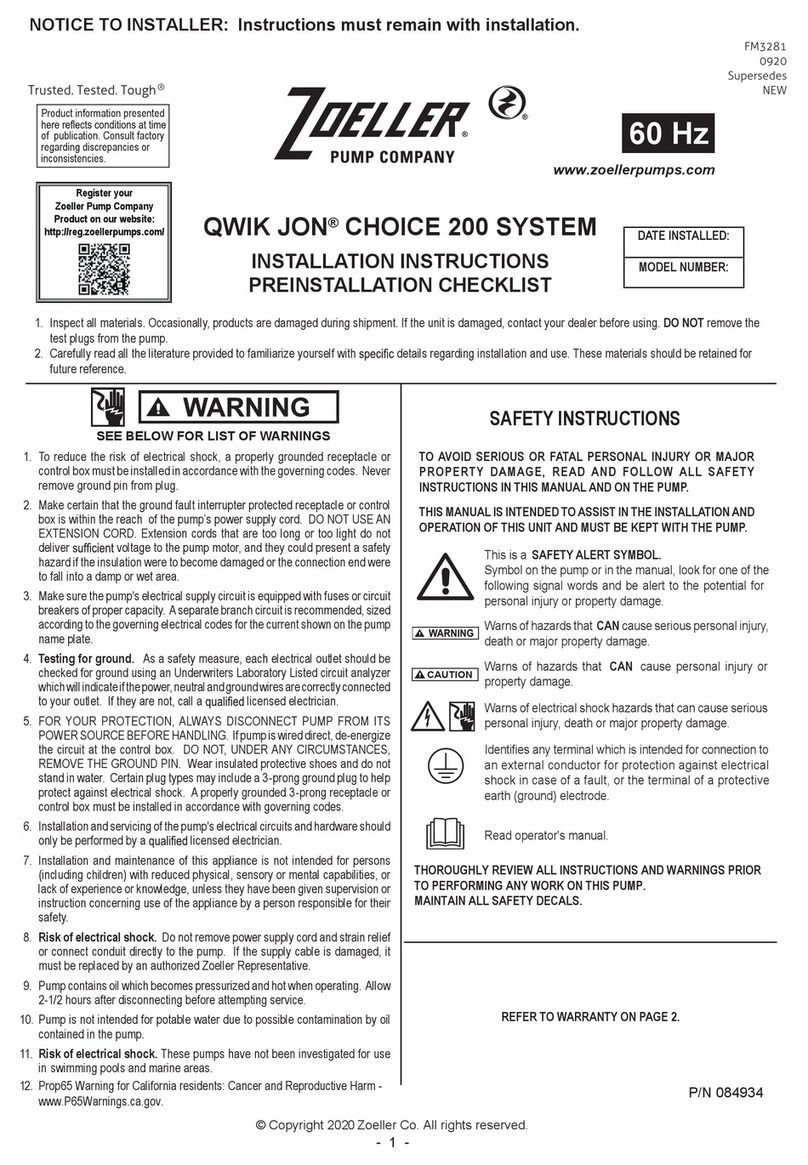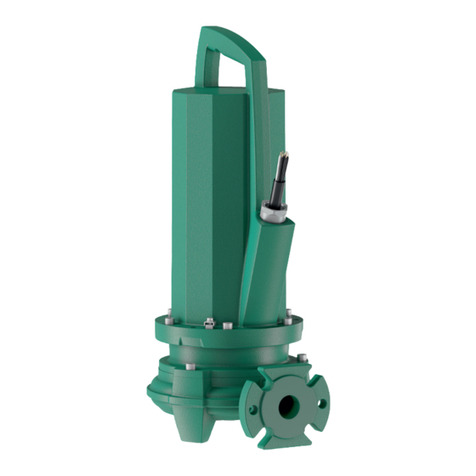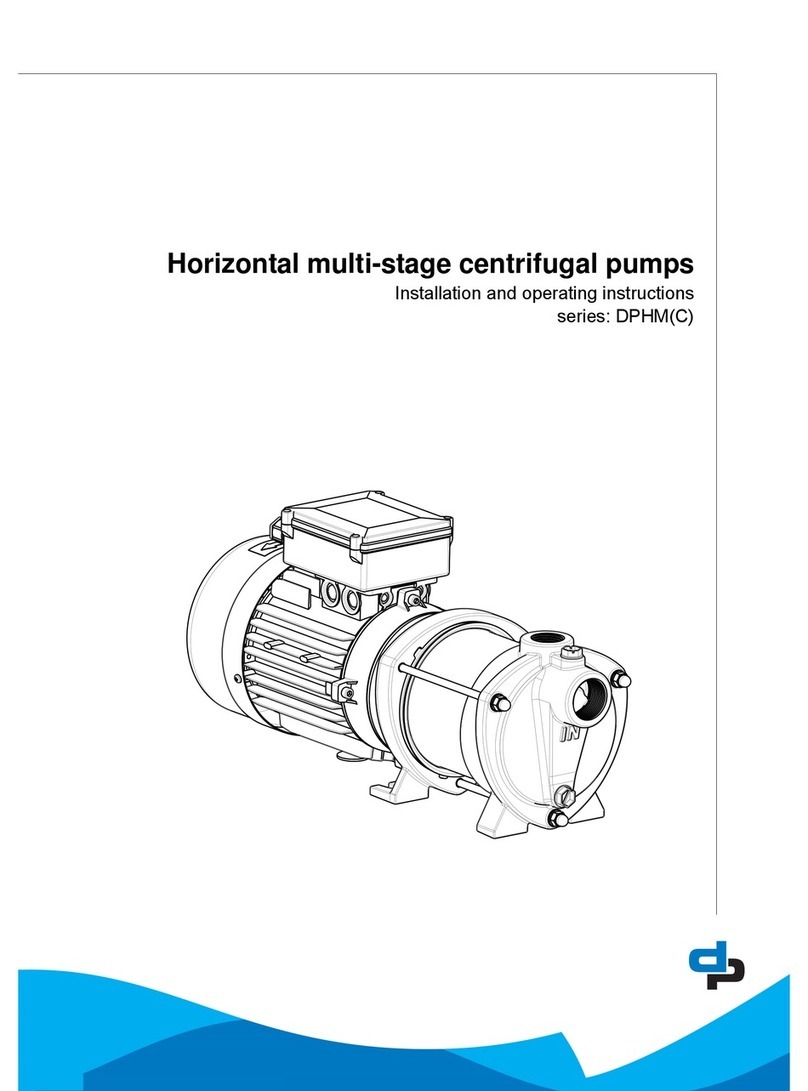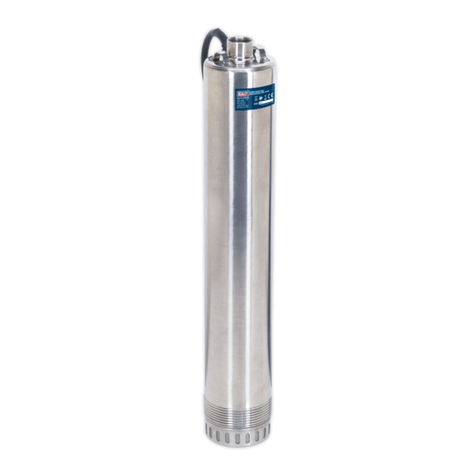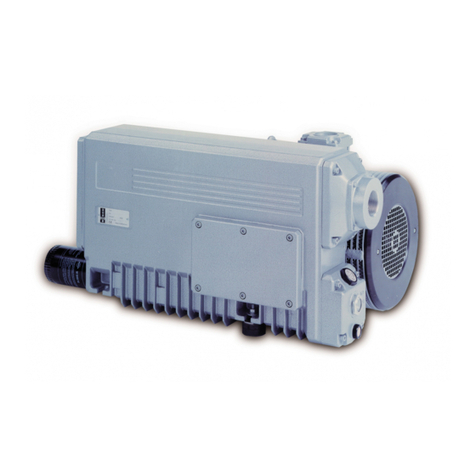Dekker RVL007 User manual

Oil-Sealed Rotary Vane Vacuum Pumps
RVL007, RVL010, RVL016, RVL030,
RVL040, RVL080, RVL125, RVL185,
RVL212, RVL400
INSTRUCTION MANUAL
300943860_A
Original instructions

Copyright notice
©2021 DEKKER Vacuum Technologies, Inc.
Trademark credit
DEKKER and the DEKKER logo are trademarks.
Disclaimer
The content of this manual may change from time to time without
notice. We accept no liability for any errors that may appear in this
manual nor do we make any expressed or implied warranties
regarding the content. As far as practical we have ensured that the
products have been designed and constructed to be safe and without
risks when properly installed and used in accordance with their
operating instructions.
We accept no liability for loss of prot, loss of market or any other
indirect or consequential loss whatsoever.
Product warranty and limit of liability are dealt with in our standard
terms and conditions of sale or negotiated contract under which this
document is supplied.
You must use this product as described in this manual. Read the
manual before you install, operate, or maintain the product.

Contents
1. Safety and compliance. . . . . . . . . . . . . . . . . . . . . . . . . . . . . . . . . . . . . . . . . . . . . . . 6
1.1. Denition of Warnings and Cautions. . . . . . . . . . . . . . . . . . . . . . . . . . . . . . . . . 6
1.2. Trained personnel . . . . . . . . . . . . . . . . . . . . . . . . . . . . . . . . . . . . . . . . . . . . . . . . . . . 6
1.3. Safety symbols. . . . . . . . . . . . . . . . . . . . . . . . . . . . . . . . . . . . . . . . . . . . . . . . . . . . 8
2. Important safety information. . . . . . . . . . . . . . . . . . . . . . . . . . . . . . . . . . . . . . . . . 9
2.1. General precautions . . . . . . . . . . . . . . . . . . . . . . . . . . . . . . . . . . . . . . . . . . . . . . . . . 9
2.2. Safety precautions during installation. . . . . . . . . . . . . . . . . . . . . . . . . . . . . . . . 9
2.3. Safety precautions during operation. . . . . . . . . . . . . . . . . . . . . . . . . . . . . . . . . 11
2.4. Safety precautions during maintenance or repair. . . . . . . . . . . . . . . . . . . 12
3. Description. . . . . . . . . . . . . . . . . . . . . . . . . . . . . . . . . . . . . . . . . . . . . . . . . . . . . . . . . 15
3.1. Vacuum and ow rate. . . . . . . . . . . . . . . . . . . . . . . . . . . . . . . . . . . . . . . . . . . . . . . 15
3.2. Overview. . . . . . . . . . . . . . . . . . . . . . . . . . . . . . . . . . . . . . . . . . . . . . . . . . . . . . . . . . . . 16
3.3. Air ow . . . . . . . . . . . . . . . . . . . . . . . . . . . . . . . . . . . . . . . . . . . . . . . . . . . . . . . . . . . . . 17
3.4. Oil ow . . . . . . . . . . . . . . . . . . . . . . . . . . . . . . . . . . . . . . . . . . . . . . . . . . . . . . . . . . . . 24
4. Technical data. . . . . . . . . . . . . . . . . . . . . . . . . . . . . . . . . . . . . . . . . . . . . . . . . . . . . . 25
4.1. Pump performance graphs. . . . . . . . . . . . . . . . . . . . . . . . . . . . . . . . . . . . . . . . . 25
4.2. Reference conditions and limitations. . . . . . . . . . . . . . . . . . . . . . . . . . . . 30
4.3. Pump data. . . . . . . . . . . . . . . . . . . . . . . . . . . . . . . . . . . . . . . . . . . . . . . . . . . . . . 34
4.4. Motor data. . . . . . . . . . . . . . . . . . . . . . . . . . . . . . . . . . . . . . . . . . . . . . . . . . . . . . 36
5. Installation. . . . . . . . . . . . . . . . . . . . . . . . . . . . . . . . . . . . . . . . . . . . . . . . . . . . . . . . . 38
5.1. Dimension drawings. . . . . . . . . . . . . . . . . . . . . . . . . . . . . . . . . . . . . . . . . . . . . . . . 38
5.2. Installation guidelines. . . . . . . . . . . . . . . . . . . . . . . . . . . . . . . . . . . . . . . . . . . . . . 42
5.3. Motor installation (if applicable). . . . . . . . . . . . . . . . . . . . . . . . . . . . . . . . . . . . 44
5.4. Electrical connections. . . . . . . . . . . . . . . . . . . . . . . . . . . . . . . . . . . . . . . . . . . . . . 48
5.5. Pictographs. . . . . . . . . . . . . . . . . . . . . . . . . . . . . . . . . . . . . . . . . . . . . . . . . . . . . . . . 48
6. Operation. . . . . . . . . . . . . . . . . . . . . . . . . . . . . . . . . . . . . . . . . . . . . . . . . . . . . . . . . . 49
6.1. Initial start-up preparation. . . . . . . . . . . . . . . . . . . . . . . . . . . . . . . . . . . . . . . . . . 49
6.2. Intake lter. . . . . . . . . . . . . . . . . . . . . . . . . . . . . . . . . . . . . . . . . . . . . . . . . . . . . . . . . 49
6.3. Start the pump. . . . . . . . . . . . . . . . . . . . . . . . . . . . . . . . . . . . . . . . . . . . . . . . . . . . . 50
6.4. During operation. . . . . . . . . . . . . . . . . . . . . . . . . . . . . . . . . . . . . . . . . . . . . . . . . . . 50
6.5. Stop the pump. . . . . . . . . . . . . . . . . . . . . . . . . . . . . . . . . . . . . . . . . . . . . . . . . . . . . 50
6.6. Taking out of operation. . . . . . . . . . . . . . . . . . . . . . . . . . . . . . . . . . . . . . . . . . . . . 51
7. Maintenance. . . . . . . . . . . . . . . . . . . . . . . . . . . . . . . . . . . . . . . . . . . . . . . . . . . . . . . 52
7.1. Preventive maintenance schedule. . . . . . . . . . . . . . . . . . . . . . . . . . . . . . . . . . 52
7.2. Oil specications . . . . . . . . . . . . . . . . . . . . . . . . . . . . . . . . . . . . . . . . . . . . . . . . . . . 53
03/2021 - ©DekkerPage 3300943860_A

7.3. Storage. . . . . . . . . . . . . . . . . . . . . . . . . . . . . . . . . . . . . . . . . . . . . . . . . . . . . . . . . . . . . 54
7.4. Service kits. . . . . . . . . . . . . . . . . . . . . . . . . . . . . . . . . . . . . . . . . . . . . . . . . . . . . . . . . 54
7.5. Disposal of used material . . . . . . . . . . . . . . . . . . . . . . . . . . . . . . . . . . . . . . . . . . 54
8. Adjustments and servicing. . . . . . . . . . . . . . . . . . . . . . . . . . . . . . . . . . . . . . . . . 55
8.1. Drive motor. . . . . . . . . . . . . . . . . . . . . . . . . . . . . . . . . . . . . . . . . . . . . . . . . . . . . . . . . 55
8.2. Exhaust lter replacement . . . . . . . . . . . . . . . . . . . . . . . . . . . . . . . . . . . . . . . . . 55
8.3. Oil and oil lter change. . . . . . . . . . . . . . . . . . . . . . . . . . . . . . . . . . . . . . . . . . . . . 57
8.4. Cleaning the intake lter (optional) element. . . . . . . . . . . . . . . . . . . . . . . 58
8.5. Replacing V-belts. . . . . . . . . . . . . . . . . . . . . . . . . . . . . . . . . . . . . . . . . . . . . . . . . . 58
8.6. V-belt tensioning. . . . . . . . . . . . . . . . . . . . . . . . . . . . . . . . . . . . . . . . . . . . . . . . . . . 59
8.6.1. How to use the V-belt tension meter. . . . . . . . . . . . . . . . . . . . . . . . . . 59
9. Fault nding. . . . . . . . . . . . . . . . . . . . . . . . . . . . . . . . . . . . . . . . . . . . . . . . . . . . . . . 61
10. Accessories. . . . . . . . . . . . . . . . . . . . . . . . . . . . . . . . . . . . . . . . . . . . . . . . . . . . . . . 64
03/2021 - ©DekkerPage 4300943860_A

List of Figures
Figure 1: Vacuum and ow rate. . . . . . . . . . . . . . . . . . . . . . . . . . . . . . . . . . . . . . . . . . 15
Figure 2: Pump components. . . . . . . . . . . . . . . . . . . . . . . . . . . . . . . . . . . . . . . . . . . . . 17
Figure 3: Air ow components. . . . . . . . . . . . . . . . . . . . . . . . . . . . . . . . . . . . . . . . . . . . 18
Figure 4: Flow diagram-RVL007 and RVL010. . . . . . . . . . . . . . . . . . . . . . . . . . . . . . . 19
Figure 5: Flow diagram-RVL016. . . . . . . . . . . . . . . . . . . . . . . . . . . . . . . . . . . . . . . . . . . 20
Figure 6: Flow diagram-RVL030 and RVL040. . . . . . . . . . . . . . . . . . . . . . . . . . . . . . . 21
Figure 7: Flow diagram-RVL080, RVL185 and RVL212. . . . . . . . . . . . . . . . . . . . . . . . 22
Figure 8: Flow diagram-RVL125. . . . . . . . . . . . . . . . . . . . . . . . . . . . . . . . . . . . . . . . . . . 23
Figure 9: Flow diagram-RVL400. . . . . . . . . . . . . . . . . . . . . . . . . . . . . . . . . . . . . . . . . . 24
Figure 10: RVL007 (50 Hz - 60 Hz). . . . . . . . . . . . . . . . . . . . . . . . . . . . . . . . . . . . . . . . . 25
Figure 11: RVL010 (50 Hz - 60 Hz). . . . . . . . . . . . . . . . . . . . . . . . . . . . . . . . . . . . . . . . . 25
Figure 12: RVL016 (50 Hz - 60 Hz). . . . . . . . . . . . . . . . . . . . . . . . . . . . . . . . . . . . . . . . . 26
Figure 13: RVL030 (50 Hz - 60 Hz). . . . . . . . . . . . . . . . . . . . . . . . . . . . . . . . . . . . . . . . . 26
Figure 14: RVL040 (50 Hz - 60 Hz). . . . . . . . . . . . . . . . . . . . . . . . . . . . . . . . . . . . . . . . . 27
Figure 15: RVL080 (50 Hz - 60 Hz). . . . . . . . . . . . . . . . . . . . . . . . . . . . . . . . . . . . . . . . . 27
Figure 16: RVL125 (50 Hz - 60 Hz). . . . . . . . . . . . . . . . . . . . . . . . . . . . . . . . . . . . . . . . . . 28
Figure 17: RVL185 (50 Hz - 60 Hz). . . . . . . . . . . . . . . . . . . . . . . . . . . . . . . . . . . . . . . . . 28
Figure 18: RVL212 (50 Hz - 60 Hz). . . . . . . . . . . . . . . . . . . . . . . . . . . . . . . . . . . . . . . . . . 29
Figure 19: RVL400 (50 Hz - 60 Hz). . . . . . . . . . . . . . . . . . . . . . . . . . . . . . . . . . . . . . . . . 29
Figure 20: Dimension drawing RVL007. . . . . . . . . . . . . . . . . . . . . . . . . . . . . . . . . . . . 38
Figure 21: Dimension drawing RVL010. . . . . . . . . . . . . . . . . . . . . . . . . . . . . . . . . . . . 38
Figure 22: Dimension drawing RVL016. . . . . . . . . . . . . . . . . . . . . . . . . . . . . . . . . . . . 39
Figure 23: Dimension drawing RVL030. . . . . . . . . . . . . . . . . . . . . . . . . . . . . . . . . . . . 39
Figure 24: Dimension drawing RVL040. . . . . . . . . . . . . . . . . . . . . . . . . . . . . . . . . . . . 40
Figure 25: Dimension drawing RVL080. . . . . . . . . . . . . . . . . . . . . . . . . . . . . . . . . . . . 40
Figure 26: Dimension drawing RVL125. . . . . . . . . . . . . . . . . . . . . . . . . . . . . . . . . . . . . 41
Figure 27: Dimension drawing RVL185. . . . . . . . . . . . . . . . . . . . . . . . . . . . . . . . . . . . . 41
Figure 28: Dimension drawing RVL212. . . . . . . . . . . . . . . . . . . . . . . . . . . . . . . . . . . . . 42
Figure 29: Dimension drawing RVL400. . . . . . . . . . . . . . . . . . . . . . . . . . . . . . . . . . . . 42
Figure 30: Motor coupling half position RVL080. . . . . . . . . . . . . . . . . . . . . . . . . . . . 45
Figure 31: Motor coupling half position RVL185 and RVL212. . . . . . . . . . . . . . . . . . 46
Figure 32: Belt tensioning. . . . . . . . . . . . . . . . . . . . . . . . . . . . . . . . . . . . . . . . . . . . . . . . 59
03/2021 - ©DekkerPage 5300943860_A

1. Safety and compliance
1.1. Denition of Warnings and Cautions
NOTICE:
For safe operation from the start, read these instructions carefully
before you install or commission the equipment and keep them safe
for future use.
Read all the safety instructions in this section and the rest of this
manual carefully and make sure that you obey these instructions. The
equipment must only be operated and maintained by trained
personnel in the proper condition and as described in this instruction
manual.
Obey local and state requirements and regulations. If you have any
questions about safety, operation or maintenance of the device,
please contact our nearest subsidiary.
Important safety information is highlighted as warning and caution
instructions. Obey these instructions.
WARNING:
If you do not obey a warning, there is a risk of injury or death.
Different symbols are used according to the type of hazard.
CAUTION:
If you do not obey a caution, there is a risk of minor injury, damage to
equipment, related equipment or process.
NOTICE:
Information about properties or instructions for an action which, if
ignored, will cause damage to the pump or the system.
We reserve the right to change the design and the stated data. The
illustrations are not binding.
Keep the instructions for future use.
1.2. Trained personnel
“Trained personnel” for the operation of this equipment are
03/2021 - ©DekkerPage 6300943860_A
300943860_A - Safety and compliance

▪skilled workers with knowledge in the elds of mechanics, electrical
engineering, pollution abatement and vacuum technology and
▪personnel specially trained for the operation of vacuum pumps.
03/2021 - ©DekkerPage 7300943860_A
300943860_A - Safety and compliance

1.3. Safety symbols
The safety symbols on the products show the areas where care and
attention is necessary.
The safety symbols that follow are used on the product or in the
product documentation.
Warning/Caution
An appropriate safety instruction must be followed or
caution to a potential hazard exists.
Warning - Automatic start up
The equipment can be remotely started.
03/2021 - ©DekkerPage 8300943860_A
300943860_A - Safety and compliance

2. Important safety information
2.1. General precautions
WARNING: AUTOMATIC RESTART AFTER VOLTAGE
FAILURE
Risk of injury and damage to equipment. If the machine is equipped
with an automatic restart after voltage failure function and if this
function is active, the machine will restart automatically when the
power is restored if it was running when the power was interrupted.
1. The operator must employ safe working practices and observe all
related work safety requirements and regulations.
2. If any of the following statements does not comply with the
applicable legislation, the stricter of the two shall apply.
3. The vacuum pump is designed for handling atmospheric air only.
No other gases, vapours or fumes should be exposed to the vacuum
pump intake or processed by the vacuum pump.
4. Before any maintenance, repair work, adjustment or any other non-
routine checks, stop the vacuum pump, press the emergency stop
button, switch off the voltage and make sure that the pump system
is at atmospheric pressure level. In addition, the power isolating
switch must be opened and locked.
5. Avoid contact with pump intake during operation.
6. The owner is responsible for maintaining the unit in a safe
operating condition. Parts and accessories shall be replaced if
unsuitable for safe operation.
7. Do not walk or stand on the unit or its components.
2.2. Safety precautions during installation
The machine must only be lifted using suitable equipment in
accordance with the applicable safety regulations. Loose or pivoting
parts must be securely fastened before lifting. It is strictly forbidden to
stay in the risk zone under a lifted load. Lifting acceleration and
deceleration must be kept within safe limits. Wear a safety helmet
when working in the area of overhead or lifting equipment.
1. The unit is designed for indoor use. If the unit is installed outdoors,
special precautions must be taken, consult your supplier.
2. Place the machine where the ambient air is as cool and clean as
possible. If necessary, install a suction duct. Do not obstruct the air
inlet. Water handling capacity is limited.
3. Blanking anges, plugs, caps and desiccant bags must be removed
before connecting the pipes.
4. Air hoses must be of the correct size and suitable for the working
pressure. Never use frayed, damaged or worn hoses. Distribution
03/2021 - ©DekkerPage 9300943860_A
300943860_A - Important safety information

pipes and connections must be of the correct size and suitable for
the working pressure.
5. The aspirated air must be free of ammable fumes, vapours and
particles, e.g. paint solvents that can lead to internal re or
explosion.
6. Arrange the air intake such that loose clothing worn by people
cannot be sucked in.
7. No external force may be exerted on the inlet and outlet
connections, the connected pipes must be free of strain.
8. If remote control is installed, the machine must bear a clear sign
stating:
DANGER: This machine is remotely controlled and may start
without warning.
The operator must make sure that the machine is stopped,
depressurised and that the electrical isolating switch is open, locked
and labelled with a temporary warning before any maintenance or
repair. As a further safeguard, persons switching remotely
controlled machines must take adequate precautions to make sure
that there is no one checking or working on the machine. To this
end, a suitable notice shall be afxed to the start equipment.
9. Air-cooled machines must be installed in such a way that an
adequate ow of cooling air is available and that the exhausted air
does not recirculate to the inlet.
10. The electrical connections must correspond to the applicable codes.
The machines must be earthed and protected against short circuits
by fuses in all phases. A lockable power isolating switch must be
installed near the pump.
11. On machines with an automatic start/stop system or if the
automatic restart function after voltage failure is activated, a sign
stating "This machine may start without warning" must be afxed
near the instrument panel.
12. In multiple vacuum pump systems, manual valves must be installed
to isolate each pump. Non-return valves (check valves) must not be
relied upon for isolating multiple systems.
13. Never remove or tamper with the safety devices, guards or
insulation installed on the machine.
14. Piping or other parts with a temperature in excess of 70 ˚C (158 ˚F)
and which may be accidentally touched by personnel in normal
operation must be guarded or insulated. Other high temperature
piping must be clearly marked.
15. For water-cooled machines, the cooling water system installed
outside the machine has to be protected by a safety device with set
pressure according to the maximum cooling water inlet pressure.
16. If the ground is not level or has variable inclination, consult the
manufacturer.
17. Pump outlet air contains traces of oil mist. Make sure that it is
compatible with the working environment.
03/2021 - ©DekkerPage 10300943860_A
300943860_A - Important safety information

18. When the air that has hazardous substances is sucked in (for
example, biological or microbiological agents), use the abatement
systems (given upstream of the pump).
19. Any vacuum pump placed in an application with inlet gas stream
temperatures above the published maximum temperature should
be approved by us prior to start-up.
Note:
Consult Safety precautions during operation on page 11 and Safety
precautions during maintenance or repair on page 12.
These precautions apply to machinery processing or consuming air
or inert gas. Processing of any other gas requires additional safety
precautions typical to the application which are not included
herein.
Some precautions are general and cover several machine types and
equipment, hence some statements may not apply to your
machine.
2.3. Safety precautions during operation
1. Never touch any piping or components of the vacuum pump during
operation.
2. Use only the correct type and size of hose end ttings and
connections. Make sure that a hose is fully depressurised before
disconnecting it.
3. Persons switching on remotely controlled machines shall take
adequate precautions to make sure that there is no one checking or
working on the machine. To this end, a suitable notice shall be
afxed to the remote start equipment.
4. Never operate the machine when there is a possibility of taking in
ammable or toxic fumes, vapours or particles.
5. Never operate the machine below or in excess of its limit ratings.
6. Keep all bodywork doors shut during operation. The doors may be
opened for short periods only, e.g. to carry out routine checks. Wear
ear protectors when opening a door.
On vacuum pumps without bodywork, wear ear protection in the
vicinity of the machine.
7. People staying in environments or rooms where the sound pressure
level reaches or exceeds 80 dB(A) shall wear ear protectors.
03/2021 - ©DekkerPage 11300943860_A
300943860_A - Important safety information

8. Periodically check that:
▪All guards are in place and securely fastened
▪All hoses and/or pipes inside the machine are in good
condition, secure and not rubbing
▪There are no leaks
▪All fasteners are tight
▪All electrical leads are secure and in good order
▪Safety valves and other pressure relief devices are not
obstructed by dirt or paint
▪Air outlet valve and air net, i.e. pipes, couplings, manifolds,
valves, hoses, etc. are in good repair, free of wear or abuse
▪Electrical cabinet air cooling lters are not clogged
9. If warm cooling air from vacuum pumps is used in air heating
systems, e.g. to warm up a workroom, take precautions against air
pollution and possible contamination of the breathing air.
10. On water-cooled vacuum pumps using open circuit cooling towers,
protective measures must be taken to avoid the growth of harmful
bacteria such as Legionella pneumophila bacteria.
11. Do not remove any of, or tamper with, the sound-damping material.
12. Do not remove or tamper with the safety devices, guards or
insulations installed on the machine.
13. The oil separator tank can be slightly pressurised. Do not open and
do not leave oil ller or drain plugs open during operation.
14. Do not use the pump as a compressor.
15. Do not run the pump without the air intake lter mounted.
Note:
Consult Safety precautions during installation on page 9 and Safety
precautions during maintenance or repair on page 12.
These precautions apply to machinery processing or consuming air or
inert gas. Processing of any other gas requires additional safety
precautions typical to the application which are not included herein.
Some precautions are general and cover several machine types and
equipment, hence some statements may not apply to your machine.
2.4. Safety precautions during maintenance or repair
1. Always use the correct safety equipment (such as safety glasses,
gloves, safety shoes, etc.).
2. Use only the correct tools for maintenance and repair work.
3. Use only genuine spare parts.
4. All maintenance work shall only be undertaken when the machine
has cooled down.
03/2021 - ©DekkerPage 12300943860_A
300943860_A - Important safety information

5. A warning sign bearing a legend such as "Work in progress, do not
start" shall be attached to the starting equipment.
6. Persons switching on remotely controlled machines shall take
adequate precautions to make sure that there is no one checking or
working on the machine. To this end, a suitable notice shall be
afxed to the remote start equipment.
7. Before you removing any component, effectively isolate the
machine from all sources of under and/or overpressure and make
sure that the pump system is at atmospheric pressure level.
8. Do not use ammable solvents or carbon tetrachloride to clean the
parts. Obey the safety precautions for toxic vapours of cleaning
liquids.
9. Observe cleanliness during maintenance and repair. Keep dirt away
by covering the parts and exposed openings with a clean cloth,
paper or tape.
10. Never weld or perform any operation involving heat near the oil
system. Oil tanks must be completely purged, e.g. by steam
cleaning, before carrying out such operations. Never weld on, or in
any way modify, pressure vessels.
11. Whenever there is an indication or any suspicion that an internal
part of a machine is overheated, the machine shall be stopped but
no inspection covers shall be opened before sufcient cooling time
has elapsed, this is to avoid the risk of spontaneous ignition of the
oil vapour when air is admitted.
12. Do not use a light source with an open ame to examine the inside
of the pump.
13. Make sure that no tools, loose parts or rags are left in or on the
machine.
14. All regulating and safety devices shall be maintained with due care
to make sure that they function properly. They may not be put out
of action.
15. Before clearing the machine for use after maintenance or overhaul,
check that operating pressures, temperatures and time settings are
correct. Check that all control and shut-down devices are installed
and that they function correctly. If removed, check that the
coupling guard of the vacuum pump drive shaft has been
reinstalled.
16. Every time the separator element is renewed, examine the
discharge and the inside of the oil separator vessel for carbon
deposits, if excessive, the deposits should be removed.
17. Protect the motor, air lter, electrical and regulating components,
etc. to prevent moisture from entering them, e.g. when steam
cleaning.
18. Make sure that all sound damping material and vibration dampers,
e.g. damping material on the bodywork and in the air inlet and
outlet systems of the vacuum pump are in good condition. If
damaged, replace it with a genuine material from the manufacturer
to prevent the sound pressure level from increasing.
03/2021 - ©DekkerPage 13300943860_A
300943860_A - Important safety information

19. Do not use caustic solvents which can damage the materials of the
air net (for example, polycarbonate bowls).
20. Faults or wearing of seals may cause oil lubricant leaks. Avoid
dispersion in soil and pollution of other materials.
Note:
Consult Safety precautions during installation on page 9 and Safety
precautions during operation on page 11.
These precautions apply to machinery processing or consuming air
or inert gas. Processing of any other gas requires additional safety
precautions typical to the application which are not included
herein.
Some precautions are general and cover several machine types and
equipment, hence some statements may not apply to your
machine.
03/2021 - ©DekkerPage 14300943860_A
300943860_A - Important safety information

3. Description
3.1. Vacuum and ow rate
A vacuum is any pressure in a system that is below the ambient
atmospheric pressure. It can be denoted in absolute terms or in
effective (gauge) terms:
▪mbar(a) – absolute pressure – denotes how much the pressure is
above absolute zero vacuum.
▪(minus) mbar(e) – the effective or gauge pressure – denotes how
much the pressure is below the local atmospheric pressure.
Figure 1 Vacuum and ow rate
1. Pressure 2. Absolute vacuum
3. Typical application working
range
4. Atmospheric pressure
1. Pressure 2. Absolute vacuum
3. Typical application working
range
4. Atmospheric pressure
Atmospheric pressure at sea level is roughly 1 bar(a) (1000 mbar(a)
(750 Torr)) or 0 bar(e) (0 Torr(e)). The typical working range for pump
applications is 400 mbar(a) (300 Torr(a)) to 100 mbar(a) (75 Torr(a)), i.e.
-600 mbar(e) (-450 Torr(e)) to -900 mbar(e) (-675 Torr(e)). This
operating pressure range is just indicative. The pumps are designed
for continuous operation between atmospheric pressure and their
ultimate pressure.
It is important to understand which type of reference is required
before selecting a pressure instrument for measuring the vacuum. It
must be noted that the distinction doesn't matter for a pressure
difference (for example, pressure loss), since it is always the result of
subtracting 2 pressures (whether stated as absolute or effective
pressures).
03/2021 - ©DekkerPage 15300943860_A
300943860_A - Description

Flow rate definitions
There are 2 common but different ways to denote ow rate in vacuum.
The rst one is based on the displacement or volumetric ow rate and
the second one is based on the throughput or mass ow rate. The
vacuum pumps use volumetric ow rate to denote performance, the
unit being actual m³/h.
Displacement/volumetric flow rate
Over the relevant pressure range, a pump operates at constant motor
speed (rotations per minute) and since the compression chambers
have xed dimensions, the same volume of air is pumped from inlet to
outlet with falling pressure level. Over the relevant pressure range, this
makes the volumetric ow rate practically independent of the vacuum
level. It is the expression of the ow rate inside the piping at the
governing vacuum level (in actual m³/h) and is always higher than the
standard ow rate (in Nm³/h).
Standard flow rate
Although the volumetric ow rate remains practically constant with
decreasing (absolute) pressure, the number of molecules in that
pumped volume is not. By denition: the deeper the vacuum, the
lower the number of molecules in the same volume. This means that
the mass ow will decrease with decreasing (absolute) pressure. A ow
rate must be stated at a certain vacuum level when using this
denotation.
3.2. Overview
The vacuum pumps are single-stage, oil-sealed and air-cooled rotary
vane vacuum pumps driven by an electric motor. The RVL400 pump is
belt driven.
The pumps have been specically designed to work with clean air,
inert gas or small amounts of water vapour. The ambient temperature
shall be between 12 °C (53.6 °F) and 40 °C (104 °F).
Note:
Lower temperatures are possible with reduced viscosity oil. This
temperature range is dened by Pneurop for performance conformity
testing, but 8 °C (46.4 °F) is the critical point from the motor starting
view point.
03/2021 - ©DekkerPage 16300943860_A
300943860_A - Description

Figure 2 Pump components
1. Air intake 2. Motor
3. Rotary vane element housing 4. Air outlet
5. Exhaust lter element housing
1. Air intake 2. Motor
3. Rotary vane element housing 4. Air outlet
5. Exhaust lter element housing
3.3. Air ow
▪Air drawn through the air intake lter (optional), the inlet protection
screen and the inlet non-return valve is displaced by the vacuum
pump element towards the air end exhaust valve. This valve ejects a
mixture of air and oil into the exhaust lter element. After passing
the exhaust lter element, clean air - conditioned to a few parts per
million - is discharged through the outlet.
▪The vacuum pump is driven by an electric motor.
03/2021 - ©DekkerPage 17300943860_A
300943860_A - Description

Figure 3 Air ow components
1. Inlet non-return valve 2. Vane (vacuum pump element)
3. Exhaust valve 4. Oil recovery valve
5. Exhaust lter element
1. Inlet non-return valve 2. Vane (vacuum pump element)
3. Exhaust valve 4. Oil recovery valve
5. Exhaust lter element
Note:
Figure: Air ow components is applicable only for the pumps RVL007
to RVL212.
03/2021 - ©DekkerPage 18300943860_A
300943860_A - Description

Figure 4 Flow diagram-RVL007 and RVL010
Outlet
PI
M
M
Non-return valve Oil separator Options :
PI = Pressure indicator
Air filter
Reservoir
Flow direction
Liquid filter
Air
Oil
Mechanical link
Enclosure for
Several components
assembled in one unit
By-pass
Vacuum pump
Motor
Ventilator
GE/2879/A
03/2021 - ©DekkerPage 19300943860_A
300943860_A - Description

Figure 5 Flow diagram-RVL016
Outlet
PI
M
M
Non-return valve Oil separator Options :
PI = Pressure indicator
Air filter
Reservoir
Flow direction
Float operated
valve
Air
Oil
Mechanical link
Enclosure for
Several components
assembled in one unit
By-pass
Vacuum pump
Motor
Ventilator
GE/2880/A
03/2021 - ©DekkerPage 20300943860_A
300943860_A - Description
This manual suits for next models
9
Table of contents
Other Dekker Water Pump manuals
